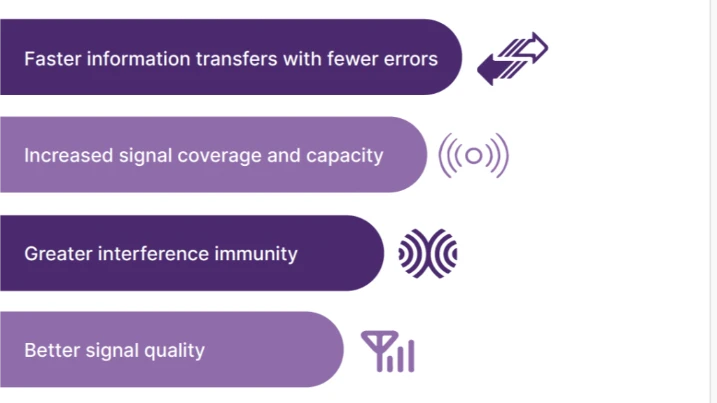In wireless communication and signal processing, beamforming stands as a crucial technology, reshaping the dynamics of data transmission and reception. Beamforming, a technology initially conceived in the 1940s, has evolved significantly and emerged as a pivotal element in enhancing modern wireless communication standards like Wi-Fi and 5G. Its integration with MU-MIMO (Multi-User, Multiple-Input, Multiple-Output) technologies empowers users by facilitating more accurate and directed connections, resulting in amplified data speeds and overall network performance.
What is Beamforming?

Beamforming is a technique where a wireless signal is directed on a single receiving device rather than broadcasting it in all directions. It enhances wireless signal bandwidth consumption while extending the range of a wireless network. Beamforming improves the signal-to-noise ratio of the received signals by eliminating undesirable interference sources. It is central to systems utilizing sensor arrays, notably in MIMO wireless communication systems like 5G, LTE, and WLAN.
Let’s go through an illustration to understand what is beamforming:
A Wi-Fi network where you want to focus the signals on the client device utilizing the network at that specific point in time.
Conventional and Adaptive Beamforming Techniques
Beamforming techniques generally fall into two types, i.e. conventional and adaptive beamforming.
In the conventional beamforming technique, the antenna array pattern is derived from static element weights that remain unchanged regardless of the signal environment. In adaptive beamforming, the element weights rely on and can adjust to the signal environment through a feedback mechanism.
Adaptive beamforming, originating in the 1960s, involves using a digital signal processor (DSP) to compute complex weights through adaptive algorithms. These weights generate an optimal (SINR) to enhance wireless communication quality.
The adaptive beamforming system dynamically adapts to different scenarios aiming to maximize SINR or minimize Interference in the desired direction. Wireless carriers commonly utilize this technology to deliver consumers advanced services like 5G and LTE.
Now that you know what beamforming is and the types of beamforming techniques, let’s look into how this technique offers faster information transfers, increased signal coverage, better signal quality and more.
How Does Beamforming Work?

Beamforming works differently based on the type of implementation. In practice, a beamforming tower or router manipulates signals by employing multiple antennas that emit diverse signals at different times. The techniques used in beamforming include:
Analog Beamforming
This method directs a single input data stream through a set of feedlines into a phased array. Each antenna receives signals with distinct phase shifts, dictating the emitted beam’s direction. The phase differences among the broadcast signals to each antenna determine the beam’s orientation.
Digital Beamforming
Here, individual antennas have their own converters. This allows for the simultaneous capture and transmission of numerous beams without stringent phase control requirements. Instead of relying on phase disparities between data streams for determining the beam steering angle, a technique called precoding integrates these beams. This superimposed transmission creates beams along multiple desired directions simultaneously.
Hybrid Beamforming
This technique combines elements from both analog and digital beamforming methods. The hybrid approach constructs transmission patterns from an antenna array using analog beamforming alongside digital precoding. It limits the number of analog beams while accommodating significant frequency variations. This technology, known as hybrid beamforming, is well-suited for implementation in 5G base stations.
Beamforming is a holy grail of networking, and its goal is to deliver high signal quality at the receiving end. When multiple signal waves get layered, interference is created that can be both constructive and detrimental, depending on how well beamforming has performed. The device that beamforms its signals is known as a Beamformer, and any device that receives beamformed signals is called a Beamformee.
5G and Beamforming
As 5G networks become increasingly prevalent worldwide for various applications, beamforming emerges as a key core technology. Especially crucial in the 5G domain due to its operation in millimeter wavelengths (mmWave), these frequencies are prone to disruptions caused by objects like walls and barriers.
By leveraging beamforming, the transmission direction from a transmitter can be precisely focused towards specific targets such as mobile devices, vehicles, or IoT devices.
In conjunction with massive MIMO (Multiple Input Multiple Output), beamforming plays a vital role, especially where ample antennas at a 5G base station direct beams horizontally and vertically. This approach aims to improve throughput and efficiency by effectively directing signals towards the user devices.
Benefits of Beamforming

Beamforming technology offers various benefits, including faster information transfers with fewer errors, increased signal coverage and capacity, greater interference immunity and better signal quality. As the signals are focused on target devices, it minimizes frequency interferences caused by nearby electromagnetic radiation from other sources. Additionally, it improves the efficiency of cellular network technologies, including 4G LTE and 5G, while enhancing the overall end-user experience.
The Future of Beamforming
Beamforming technology holds promising potential for wider integration into WiFi and 5G networks, offering substantial support to meet future demands in data rates and network capacity. Moreover, as beamforming algorithms advance, they will adeptly select the most optimal data pathways.
Beyond network base stations and wireless network routers, this technology is poised to permeate various end-user communication devices like cell phones, computers, and an array of smart gadgets.
Radar detection systems also harness the power of beamforming technology. Prior radar technologies relied on moving and steering parabolic antennas to target specific directions. Signal processing advancements have minimized the need for physical antenna movements, shaping radio waves into focused electromagnetic beams directed precisely where needed.
Nowadays, where businesses seek for more innovative approaches for evolving and meeting their objectives, beamforming stands out as a transformative force. Its expansive capabilities are set to drive continued industry growth, offering numerous benefits in the foreseeable future.




.svg)

















